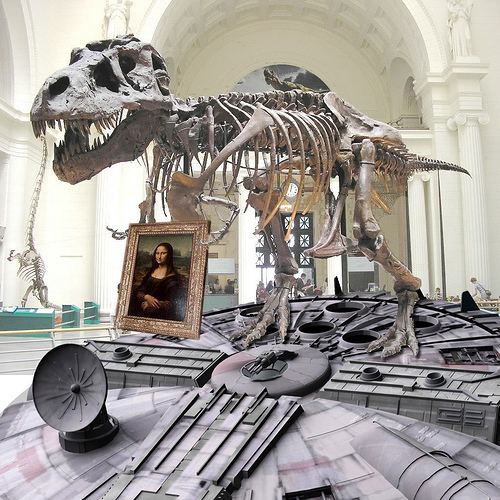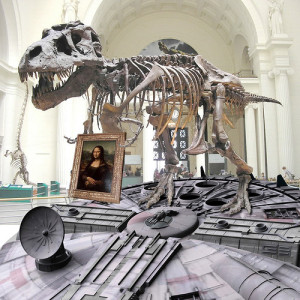Last November I went to the Museum Computer Network (MCN2011) conference for the first time – I was lucky enough to get a scholarship (for which many, many thanks). The theme was 'hacking the museum: innovation, agility and collaboration' and the conference was packed with interesting sessions.My rough notes are below, though they're probably even sketchier than usual because I had a pretty full conference (running a workshop, taking part in a panel and a debate). (I thought I'd posted this at the time, but I just found it in draft, so here goes…)
Pre-conference workshop, Wednesday
I ran a half-day workshop on 'Hacking and mash-ups for beginners', which had a great turn-out of people willing to get stuck in. The basic idea was to give people a first go at scripting 'hello world' and a bit beyond (with JavaScript, because it can be run locally), to provide some insight into thinking computationally (understanding something of programmers think and how ideas might be turned into something on a screen), to play with real museum data and try different visualisation tools to create simple mashups. My slides and speaker notes are at Hacking and mash-ups for beginners at MCN2011 and I'd be happy to share the exercises on request. I used lots of cooking/food analogies so have a snack to hand in case the slides make you hungry! I had lots of good feedback from the workshop, but I think my favourite comment was this from Katie Burns (@K8burns): '…I loved the workshop. I nerded out and kept playing with your exercises on my flight home from ATL.'.
Thursday
Kevin Slavin's (@slavin_fpo) thought-provoking keynote took us to Walter Benjamin by way of the Lascaux Caves and onto questions like: what does it do to us [as writers of wall captions and object labels] when objects provide information?. He observed, 'visitors turn to the caption as if the work of art is a question to be answered' – are we reducing the work to information? We should be evoking, rather than educating; amplifying rather than answering the question; producing a memory instead of preserving one; making the moment in which you're actually present more precious… Ultimately, the authenticity of his experience [with the artwork in the caves] was in learning how to see it [in the context, the light in which it was created]. Kevin concluded that technology is not about giving additional things to look at, but additional ways to see.
I've posted about the panel discussing 'What's the point of a museum website?' I was in after the keynote at Report from 'What's the point of a museum website'… and Brochureware, aggregators and the messy middle: what's the point of a museum website?. I also popped into the session 'Valuing Online-only Visitors: Let's Get Serious' which was grappling with many of the issues raised by Culture 24's action research project, How to evaluate success online?. This all seems to point to a growing momentum for finding new measurable models for value and engagement, possibly including online to on-site conversion, impact, even epiphanies. Interestingly, crowdsourcing is one place where it's relatively easy to place a monetary value on online action – @alastairdunning popped up to say: 'http://www.oucs.ox.ac.uk/ww1lit/ project – 'Normal' digitisation = £40 per item. Crowdsourced = £3.50 per item', adding 'But obviously cultural value of a Wilfred Owen mss is more than your neighbour's WW1 letters and diaries'.
Friday
One of the sessions I was most looking forward to was Online cataloguing tools and strategies, as it covered crowdsourcing, digital scholarly practices and online collections – some of my favourite things!
Digital Mellini turned 17th C Italian manuscript (an inventory of paintings written in rhyming verse) into an online publication and a collaboration tool for scholars. The project asked 'What will digital art history look like?'. The old way of doing art history was about solo exploration, verbal idea-sharing, physical book publications, unlinked data, image rights issues; but the promise of digital scholarship is: linked data opens new routes to analysis, scholars collaborate online, conversations are captured, digital-only publications count for tenure, no copyright restrictions… I was impressed by their team-based, born-digital approach, even if it's not their norm: 'the process was very non-Getty, it was iterative and agile'. They had a solid set of requirements included annotations and conversations at the word or letter level of the text, with references to related artworks. They're now tackling 'rules of engagement' for scholars – where to comment, etc – and working out what an online publication looks like and how it affects scholarly practices.
Yale Center for British Art (YCBA) Online Collections's goal was search across all YCBA collections. All the work they've done is open source – Solr, Lucene – cool! They're also using LIDO (superceding CDWA and MuseumDat) and looking to linked data including vocabulary harmonisation. As with many cross-catalogue projects, they ended up using a lowest common denominator between collections and had to compromise on shared fields in search. I'm not sure who used the lovely phrase 'dedication to public domain'… Both art history presentations mentioned linked data – we've come far!
The final paper was Crowdsourcing transcription: who, why, what and how, with Perian Sully from Balbao Park talking with Ben Brumfield about how they've used his 'From the Page' transcription software. Transcription is not only useful because you can't do OCR on cursive writing, but it's also a form of engagement and outreach (as I've found with other cultural heritage crowdsourcing). They covered some similar initiatives like Family Search Indexing, whose goal is to get 175,000 new user volunteering to transcribe records (they've already transcribed close to a billion records) and the Historic Journals project whose goal is to link transcriptions with records in genealogy databases (and lots more examples but these were most relevant to my PhD research).
Reasons for crowd participation (from an ornithology project survey) included the importance of the programme, filling free time, love of nature, civic duty and school requirement. People participate for a sense of purpose, love of the subject, immersion in the text (deep reading). The question of fun leads into peril of gamification – if you split text line by line to make a microtask-style game, you lose the interesting context.
They gave some tips on how to start a crowdsourced transcription project based on your material and the uses for your transcription. The design will also affect interpretive decisions made when transcribing – do you try to replicate the line structure on the page? – and can provide incentives like competition to transcribe more materials, though as Perian pointed out, accuracy can be affected by motivation.
I had to leave Philosophical Leadership Needed for the Future: Digital Humanities Scholars in Museums early but it all made a lot more sense to me when I realised Neal wasn't using 'digital humanities' in the sense it's used academically (the application of computational techniques to humanities research questions) – as I see it, he's talking about something much closer to 'digital heritage'.
I still haven't sorted out my notes from History Museums are not Art Museums: Discuss! but it was one of my favourite sessions and a great chance to discuss one of my museumy interests with really smart people.
Saturday
I popped into a bit of THATCamp/CultureHack and had fun playing with an imaginary museum, but unfortunately I didn't get to spend any time in the THATCamp itself, because…
The MCN 'Great Debate'
I was invited to take part in the Great Debate held as the closing plenary session. I was on the affirmative side with Bruce Wyman, debating 'there are too many museums' against Rob Stein and Roseanna Flouty. For now, I think I'll just say that I think it's the hardest bit of public speaking I've ever done – the trickiness of the question was the least of it! I think there's a tension between the requirements of the formal debating structure and the desire to dissect the question so you can touch on issues relevant to the audience, so it'll be interesting to see how the format might change in future.
Finally, a silly tweet from me: '#mcn2011 I've decided the perfect visitor-friendly museum is the Mona Lisa on spaceship held by a dinosaur. That you can buy on a t-shirt.' lead to the best thing ever from @timsven: '@mia_out- this pic is for you- museum of the future: trex w/ mona lisa riding millenium falcon #MCN2011 http://t.co/37GdAD1O'.


One thought on “Museum Computer Network 2011 conference notes”